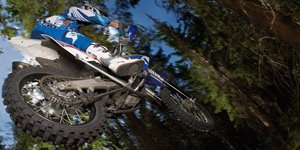The basic components of steering include rake, trail, and offset.
The trail plays a role in stabilizing the front-end by helping your tire produce a restoring force that attempts to keep your motorcycle moving in a straight line. The longer the trail, the more the motorcycle will resist turns and be more stable on straight line driving. A shorter trail allows for quick and easier turns. The shorter trail makes the motorcycle want to "fall" into the turns.
The rake plays a role by allowing any lean of the wheel to be transformed into a turn of the wheel towards that lean. A more vertical rake allows the bike to handle bumps and ruts well, HOWEVER, by having a smaller rake you create a smaller trail and forfeit some straight line driving stability. A smaller rake also produces a lighter handling feel when turning. As you increase the rake, the motorcycle will produce a more heavier or sluggish handling feeling since the weight of the chassis is attempting to self-straighten the fork as it hangs in the steering axis.
The trail and the rake directly affect each other. If you shorten one, you automatically shorten the other. The opposite is also true. If you increase the angle of the rake, you also increase the length of the trail.
The third basic element is the offset. Offset is defined in millimeters (mm) and is measured from the centerline of the top of the steering stem axis to the centerline of the top of the fork tubes. An offset provides a second option for the setup of how the motorcycle will handle. The smaller offsets (35mm - 60mm) allows the motorcycle to angle more into the corner and push through the turn. However on exiting the corner, you will experience less traction allowing you to turn easier and stay on the inside of the track. As you increase the offset (60mm - 75mm) you obtain more traction coming out of the corners, but the greater offset forces the motorcycle into an upright position and you will drive more towards the outside of the track coming off the corner.
Other factors such as weight transer when braking, fork length, and tire size may also play a role in changing the trail and rake and should be given consideration when determining your set-up.

















![Validate my Atom 1.0 feed [Valid Atom 1.0]](http://i41.tinypic.com/i71vv5.png)
